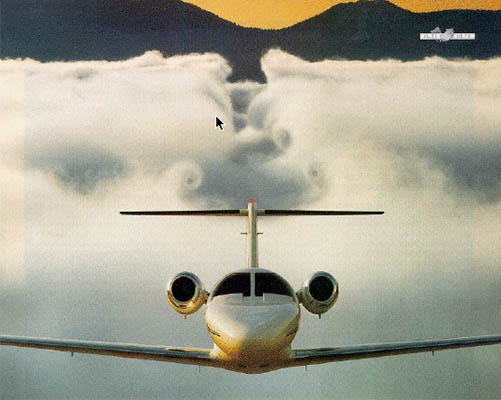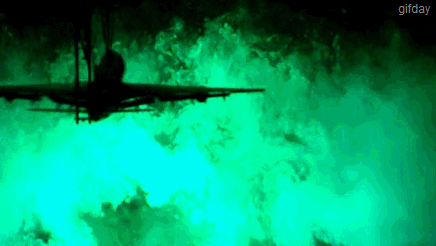
AIRPLANE FLIGHT ANALOGY
1997 William Beaty
The decades-old controversy about wings and the lifting force has a definite origin. It arises because two-dimensional airfoils are used to teach us about pressure and flow patterns... and then we apply those concepts to 3D wings.
This is a major mistake. The behavior of 3D wings is fundamentally
different than the behavior of 2D airfoils. Going from 2D to 3D is
not a trivial change.
In our 3D world, airplanes behave like hovering helicopters,
producing a downwards-moving plume of air. When flying horizontally, the
plume of air becomes a downstream
wake which carries away downwards momentum, and constitutes a net
downwash. The wing injects downwards momentum into local air parcels,
and
this air keeps moving downward long after the aircraft has departed.
We
encounter this as a wide, descending air mass commonly labeled
"tip-vorticies."
But in the 2D world of the wind-tunnel, there is no such
downward-moving wake behind the wing. Instead, the 2D upwash must always
be exactly equal to the 2D downwash, and the wing does not push upon the
air. Instead, all the momentum is injected directly and instantly into
the distant
floor/ceiling. Even more important, 3D wings have finite
dimensions,
while 2D wings act as if they have infinite span. An infinite wingspan
gives some exceeding strange results; odd results never produced by finite
3D wings in the real world.
For example, if a 2D infinitely-wide wing should ever deflect even a tiny
portion
of the oncoming air downwards (deflecting a streamline,) it would deflect
an infinite amount of air, and produce an infinite lifting force.
As a result, a 2D infinite airfoil does an odd thing: it applies a
finite force to an infinite mass of air. In response, a net amount
of air does NOT move downwards (since it has infinite mass.) The incoming
and outgoing streamlines remain horizontal. The wing doesn't deflect any
air at all, on average. The wing acts like a weird reaction
engine, a strange engine where the "exhaust gasses" have zero velocity and
infinite mass. This strange effect only applies to 2D airfoils and
to infinitely-wide wings, and obviously is never encountered with real 3D
airplanes flying through 3D air.
In other words, flight of airplanes in the real world is an example of
reaction engines
and propulsion, same
as with hovering helicopters and hovering rocket engines. Real wings are
reaction engines. But the flight
of a 2D airfoil is not propulsion, and doesn't inherently require any
fuel. Real 3D airplanes require fuel, even when flying in an idealized
zero-friction environment. (Real helicopters and rocket engines are the
same. But a rocket engine with an infinitely-wide engine-bell does not
need fuel and is not a reaction engine. The same is true of a helicopter
with infinitely-wide rotor blades ...and true for a two-dimensional
airfoil in a world of 2D streamlines.)
I attempt to explain the problem in words, but words are easily
misunderstood (especially on hot-button issues where emotions run high.)
A visual analogy works much better. Below is my explanation for how a
three-dimensional airplane flies through 3D air. It is very different
than the typical 2D explanations found in most textboooks. My
"circulation" is flipped ninety degrees!
Take a look at my animated crude GIF diagram, and also see the green smoke
laser-scanned video segment of a model 747 producing a downwash pattern.
fig. 1
DISK-BALLOON WITH A SMALL PLATFORM
_____
_-- --_
/ \
__| . |
| |
\_ _/
--_____--
Now suppose I were to leap from the top of a ladder and onto the balloon's
small platform. The balloon would move downwards. It would also rotate
rapidly counterclockwise, and I would be dumped off.
Next, suppose we have TWO giant disk-shaped balloons stacked adjacent to
each other like pancakes standing on edge.
ad:


